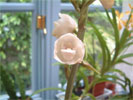|
|
|
|
|
| |
Established Seedlings of
Peristeria elata 'MC3914' × self |
|
| |
|
|
| |
| Number: |
TN5713 |
| Name: |
Peristeria elata 'MC3914' × self
|
| Type: |
self (What's that?) |
|
Click to Enlarge

Pod Parent Flowers |
|
|
|
| |
Culture Notes from Donor: Parent plant: Temperature range I (60-83°F)
Comments: Parent plant: Very large plant.
For additional origin/habitat information supplied courtesy of
Charles and Margaret Baker, see further below, near the bottom of this page.
|
Temperatures we attempt to use in the lab & greenhouse:
| For Species: |
|
Spring, Summer, Autumn, Winter: days average 85°F, nights 72°F; best fit is Warm 90-70°F
(Source:
Baker's Web OSC) |
|
About the name...
| Etymology of |
elata |
|
From Latin "elatus" exalted, high, lofty.
(Source:
Brown 1956) |
| Etymology of |
Peristeria |
|
From Greek "peristerion" little dove. In reference to the similarity of the column, anther, lateral lobes of the lip to a dove with spread wings.
(Source:
Pridgeon 1992) |
| Etymology of |
peristeria |
|
From latinized Greek "peristerius" dove-like.
(Source:
Mayr & Schmucker 1998) |
| Pronunciation of |
elata |
|
e-LAH-ta
(Source:
Hawkes 1978) |
| Pronunciation of |
peristeria |
|
per-is-TER-ee-ah
(Source:
Pridgeon 1992) |
|
If you would like to direct someone to this web page, please copy and paste this URL into your email:
http://troymeyers.com/d?125713
ESTABLISHED SEEDLINGS
of these are not currently available.
We do not have any unsold in the greenhouse, but may offer them in the future.
Click here to see if we have flasks available.
|
|
|
| |
The origin/habitat information below is supplied courtesy of Charles and Margaret Baker
The following information is based on the name of the plant provided by the donor, and assumes that the name is correct. If the plant has been misidentified, then the following information may not be correct.
This text is copyrighted by the Bakers and may not be reproduced without permission.
ORIGIN/HABITAT: Costa Rica, Panama, Colombia, Venezuela, and Ecuador. In
the wild, Peristeria elata typically inhabits heavily shaded to semisunny
areas on the edge of wooded tracts. They are found in regions which have
heavy rainfall most of the year with at least a month of drier conditions.
They are reported to be terrestrials because they grow on the ground. It
would probably be more accurate if they were referred to humus epiphytes,
however, they actually grow on a deep layer of rotting leaves and forest
debris with their roots barely penetrating the ground beneath.
In Costa Rica, plants are found in the lowlands along both the Pacific and
Caribbean coasts as well as the lower mountain region. Dressler (1993)
reported that these plants grow in open, rocky areas and on steep, grassy
slopes, which is a type of habitat that is now more common as forests
continue to be cleared. He indicated that these orchids would probably be
rather common if people would simply leave them where they are growing.
In Panama, collections are reported in the Canal Zone, in Panama Province
in the plains and foothills east of Panama City near Río Tecúmem at 350
ft. (100 m) between sea level and 2000 ft. (0-610 cm), In Cerro Santa Rita
in Colón Province plants grow in roadside grass at about 1200 ft. (370 m),
and in El Valle de Antón at 1800 ft. (550 m) in Coclé Province.
In Colombia, this is the most common species of the genus, and it grows
under hot conditions at elevations below 3300 ft. (1000 m).
In Venezuela, plants are reported near Altamira in the State of Barinas
and at 6550 ft. (2000 m) near Trujillo in the State of Trujillo. This is
the only report of a habitat above 3300 ft. (1000 m), however, so we
suspect that the collection may have been made at 2000 ft. (610 m) and the
wrong unit of measurement was accidentally used to report the elevation.
In Ecuador, plants grow on grassy slopes in wet tropical forests and have
been collected in Los Rios Province near Montalvo at 350 ft. (100 m) as
well as several other Provinces on the western slopes of the Andes.
Peristeria elata reportedly grows well in a garden at 1950 ft. (600 m)
near Sto. Domingo in Pichincha Province.
More about this information and the Bakers...
|
|
|
| |
|
|
|